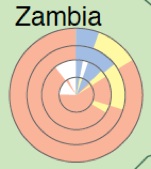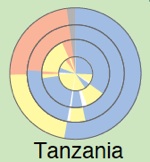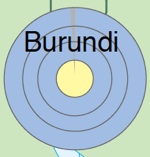Transfer of Status
Type of Status Transfer
The term „Status Transfer“ does not perfectly grasp the basics of the issue here. The concept is about the attempt to simultaneously focus on cultural norms in four different domains:
- What are the succession rules to the position of local headmen (R71)?
- What are the inheritance rules of land (R73)?
- What are the postmarital residence rules (R11)?
- What are the rules of descent in different fields (R43)?
The four domains are coded in the same way. In every department, two dimensions were captured, viz.:
Dimension 1: the importance of uni-lineal descent for regulating the intergenerational transmission of rights and duties. Since descent always includes two different families (due to the incest taboo), the point here is whether this universal fact is culturally reduced and prescribed to one single line, either father´s or mother´s line. The dimension is called lineality. If lineality plays no role in any of the four domains, the system is called Cognatic.
Dimension 2: (in case of lineal rules in any of the above domains): what is the preferred line? Is it basically matrilineal or patrilineal?
In principle, each domain may follow different rules. In the empirical reality, however, there is a tendency for ideological consistency, particulary with patri-orientation. The triangular model below allows to type any empirical configuration of rules:
Comment:
Yellow (B) signifies all four domains are non-linieal, or cognatic.
At the foot of the pyramid are societies with lineal descent rules: on the left (A): all patrilineal; on the right (C): all matrilineal; in between (E): mixed uni-lineal rules. The types D, E, F and G indicate combinations which are self-explanatory.
The objective of the two maps Type of Status Transfer and Type of Kinship System is to give an impression of the relative weight of patrilineal, matrilineal and non-lineal (cognatic) social systems in the world.
On the Map Status Transfer, largely four colors prevail: the three basic forms patri-, matri- and non-lineal (blue, red and yellow) plus type D (green) which refers to societies with a combination of patrilineal and non-lineal rules for ascription. In generalizing terms, these are the rough lines:
- In China, India and large parts of Africa, the local social organization is largely patrilineal in all four domains (blue).
- The Arab world is patri-dominant, too, but less so in all four domains (green).
- In Southeast Asia, as in Turkey and Kazakhstan, non-linear (cognatic) rules predominate (yellow).
- There is a matrifocal belt with Zambia in the center cutting across southern Africa (red). Scattered patches of similar local structures are found in a few more parts of the world (e.g. West Africa; Kerala in South India).
The local rules in the four domains may be considered proxi variables of the structural position of men and women in a society. Matrilineal ascription of status, however, should not be put on a level with equal or even superior positions of women. For instance, matrilineal succession to the position of local headmen does not imply – as the word headman indicates – that women occupy such positions. It rather means that men out of the matrilineal line are legitimized to such positions. Under such conditions, mothers may enjoy some ideological power, which is not the same as occupying a power position.
Map extract: Comment
Two ways of representing cultural rules of status transfer: The example of four African countries (click on the symbols to enlarge the view of the maps).

- The „matri-belt“ is clearly visible on the national level. It includes Zambia and Moçambique (where matrilineal rules are dominant) and Angola and Congo (where matrilineal rules are most common, but for less than 50 % of the population). Beside fully patri-focal (blue points) and matri-focal (red) societies
- On the level of local societies, the pattern does not follow national boundaries. Clearly visible are different clusters in Angola and Tanzania. In the northwestern part of the map, the large matrifocal pattern is dispersed over three different countries (Angola, Zaire, Congo). In the east, there is a patri-cluster in the border areas of Zambia, Malawi and Tanzania. In matri-oriented countries we find patri-dominant minorities, and vice versa in patri-oriented countries like Zaire.
- Tanzania is particularly diversified with respect to the matri-patri-dimension. There are many groups with an internal mix of patrilineal and matrilineal rules (green and orange color).
- The white circles represent units which are not documented in all four domains. Were they codable in future, the national values could shift to some extent in either direction.
Comment on the circles:
The figures of concentric circles display the proportions of different rules in the four social domains discussed above. Each full circle is 100 percent of the coded population of a country. The differences in institutionalized rules of the traditional local societies differ significantly among the four examples: With respect to the matri-/patri-dimension, the cultural heritage of Zambia – slightly more than Malawi – is clearly matri-focal, whereas Tanzania – and even more so Burundi – are largely patri-focal.
It is important to note that the figures mirror the frequency of certain institutional arrangements in a country, without any indication of the number of ethnic units or the institutional arrangement of any specific unit. Even in a simple case like Burundi, the same picture on national level theoretically could result from quite diverse situations: (a) one fully cognatic unit in company with one fully patrilineal unit; (b) several fully cognatic units in company with several fully patrilineal units; (3) one single unit with non-lineal succession of local headman and patrilineal rules for inheritance, residence and descent; (4) several units all of which have non-lineal succession of local headman and patrilineal rules for inheritance, residence and descent. What the figure does say is: Irrespective of the number and internal structure of the cultural units in that country, patrilineal rules are the general rule except when it comes to the succession of local headmen. The ethnic composition is of no significance in this context and searching for the correct definition of ethnic boundaries irrelevant.
Comment:
•Vertical color bars: Three basic types of rules.
•Horizontal lines: Four domains where rules are applied.
The simultaneous analysis of four different aspects of the cultural heritage leads to an unexpected conclusion. Usually the concept of cultural heterogeneity is applied for the number of ethnic units in a country: The more such units, the more heterogeneous or fractionalized a country. Cultural diversity, however, is not just a matter of language, religion and some vague ethnic identity, but rather depends on many other features of social life. 20 ethnic units with about the same economic, social and political institutions amount to much less heterogeneity than 10 units with a large variety of institutional settings. The same applies for the degree of consistency within an ethnic unit. In the case at hand this means: Social units with the same rules in all four domains discussed above are more culturally homogenous than units where different rules are applied – within and accross the much wider categories of religion or language. Nowadays such fosses also result from partial modernization and social polarization. In addition, it is telling that a strong majority of all ethnic units show a tendency towards internal consistency: either patri- or matri- or cognatic rules. The fuzzy opposite (grey color) is very rare – in the map extract, an example can be found in the border zone of Angola and Namibia.





